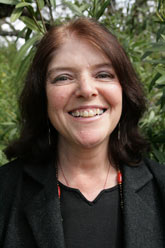
Handy Links
SLAC News Center
SLAC Today
- Subscribe
- Archives: Feb 2006-May 20, 2011
- Archives: May 23, 2011 and later
- Submit Feedback or Story Ideas
- About SLAC Today
SLAC News
Lab News
- Interactions
- Lightsources.org
- ILC NewsLine
- Int'l Science Grid This Week
- Fermilab Today
- Berkeley Lab News
- @brookhaven TODAY
- DOE Pulse
- CERN Courier
- DESY inForm
- US / LHC
SLAC Links
- Emergency
- Safety
- Policy Repository
- Site Entry Form

- Site Maps
- M & O Review
- Computing Status & Calendar
- SLAC Colloquium
- SLACspeak
- SLACspace
- SLAC Logo
- Café Menu
- Flea Market
- Web E-mail
- Marguerite Shuttle
- Discount Commuter Passes
-
Award Reporting Form
- SPIRES
- SciDoc
- Activity Groups
- Library
Stanford
Around the Bay
People: Roz Pennacchi's Adventures at SLAC
In the fall of 1976, Roz Pennacchi walked in to former SLAC Director Wolfgang "Pief" Panofsky's office for her first day of work as a receptionist. She had no idea what to expect.
"When they told me I was going to work for the director, I thought SLAC made movies," Pennacchi said, laughing. But it wasn't long before she became fascinated by the large experiments her boss oversaw.
"I had always thought storage rings were really neat," she said. "I loved the control room, all those buttons and monitors." To get closer, she transferred to a secretarial job in the PEP storage ring operations group, but she had a hard time staying out of the control room.
"I would watch how the operators ran the machines, and ask them questions. I wanted to do it, but everyone told me that you had to have been in the Navy," Pennacchi said. When she mentioned this regret to Panofsky in a casual conversation, he laughed. "He said, 'You know, there aren't that many storage rings in the world. Nobody has the training to be a storage ring operator!'" she recalled. "Pief was amazing. He encouraged people to do what they wanted to do."
Pennacchi didn't need to go into the Navy, but she did need an associate's degree in electronics. So she continued working as a secretary by day and went to school in the evenings. "I'd go to the beach on the weekends and find a nice place to sit to write up my labs," she said. Soon she was manning the controls at the SPEAR storage ring, the electron-positron collider that earned two Nobel prizes before becoming a synchrotron radiation source. She still gets a gleam in her eye when she talks about her days at SPEAR.
"It was like a video game, in the days before video games. They'd inject the beam at one energy and you'd have to tweak it just right to get it all the way up," she said, her hands reaching out for invisible knobs. At first, her transition from the office to the control room garnered a few raised eyebrows.
"Some people initially had the mentality of, 'You're a girl, you've never been in the Navy, what are you doing here?'" Pennacchi said. "But as soon as I started talking about the work, I was one of the guys. SPEAR was like my home."
Pennacchi has gotten to know SLAC's machines intimately over the years. From SPEAR she moved on to the PEP control room. After leaving PEP she spent ten years with the biggest machine on site—SLAC's linac—as area manager for the accelerator, then the damping rings, and finally the positron production system.
"Those machines have got to be working. I had to make sure the right people were on the job, and when there was a problem I stayed there until it got fixed," Pennacchi said. "I spent a lot of weekends here." When the position of "space manager" was created in 2000, it seemed a natural move for Pennacchi, given her familiarity with the SLAC site. Now she coordinates the allotment and reorganization of office and lab space, but she likes to visit her old haunts when she can.
"I went on a tour of the Linac Coherent Light Source, and I just loved the tunnels. I get chills just thinking about it," Pennacchi said. "I still think the buildings underground are a lot more fun."
Although Pennacchi's role has changed during her 30 plus years here, her reason for staying hasn't. "The people here at SLAC are what make it all worthwhile," she said. "They're the best thing about working in this place."
—Lauren Schenkman
SLAC Today, March 18, 2009
